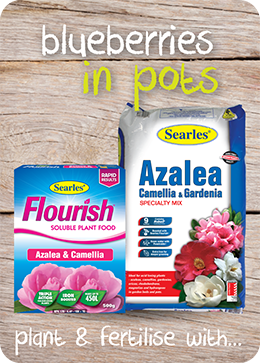|
Watching blueberry fruit blossoming is one pleasure many gardeners relish it during the warmer months and growing them in pots keeps them at arms reach. Blueberries grow well in containers, and if they have the right soil conditions, blueberries are easy to grow and will reward you with bundles of deep purple berries.
Potting Blueberries
The most important condition to get right is their soil structure. Blueberries require acidic soil, ranging in a pH of 4 to 5.5 with plenty of compost and organic matter mixed in for abundant fruiting and to endorse healthy biodynamic soil. The easiest way to set them up for potted success is to plant straight into an acidic pH mix, such as Searles Azalea, Camellia & Gardenia Specialty Mix or alternatively, Searles Fruit, Citrus & Rose Specialty Mix. This premium mix contains plenty of organic matter and fertiliser to feed for up to 9 months. This mix can be used for both potted displays and for planting straight into garden beds.
Positioning blueberries
Blueberries love a warm, sunny position and cold nights. Position potted plant in full sun.
Varieties of blueberries
They are three main varieties of blueberries. Don’t worry too much picking the right type though. Your local gardening outlet will have the best growing variety suitable for your climatic zone.
1. Northern highbush require cold winters to produce fruit easily from early summer until mid-Autumn in Southern areas of Australia. They generally lose their leaves in Winter.
2. Southern highbush love a warmer climate and will grow all along coastal areas and inland from Sydney to the tropics. With warmer weather arriving earlier, this variety will fruit late Winter until the new year. This variety may lose some or all of their leaves during Winter depending on where you live.
3. Rabbiteye are similar to Southern highbush in their liking of the cold. The name derives from the pink colour of the immature fruit akin to the colour of a rabbit’s eye.
Mulching and Watering blueberries
Blueberry plants have fine, fibrous roots which sit close to the surface of the soil, so mulching is essential to protect them from extremes of temperature and to retain moisture in the soil. Water blueberries a couple of times of week during warmer times of the year and while fruiting. They require regular watering to produce fruit. If watering is irregular, they will let you know they are not happy by poor fruiting or bud drop.
Fertilising blueberries
As any fruiting plant, they flower and fruit better with plenty of organic matter to feed their demand. If planted in Searles Azalea, Camellia & Gardenia Mix they won’t need fertilising for months. Though to promote better fruiting during the warmer months, liquid feed with Searles Azalea & Camellia Soluble Plant Food at half rate. This fertiliser is designed to add essential minerals and nutrients suitable for acid-loving soils.
Harvesting blueberries
Young blueberry plants may take a couple of years to fruit. Some experts suggest removing the flowers in the first year will help the plant develop strong and healthy root growth and stems to support future flowering and fruiting. Pick fruit when the fruit has turned mauve-blue colour.
Pruning blueberries
Blueberries don’t need much pruning. Only prune dead and wayward branches off after fruiting has finished.
Protect blueberries from birds and possums
You are not the only ones that love blueberries. Birds and possums love blueberries as much as you do and often get to them before you. Install bird-friendly netting or bags around developing fruit to say ‘no way Jose’ to these pesky thieves.
|






